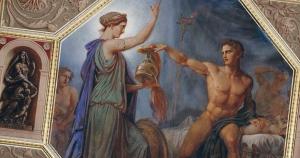I asked for new voices and got some outstanding writers! Today we hear from the erudite James R. Harrington.
 James R. Harrington earned his M.A. in Ancient History at California State University Fulleron and is a member of the Torrey Honors Institute. James has been a classical educator in a variety of settings over the past thirteen years. He lives in Houston with his wife, Sharon, and their daughter.
James R. Harrington earned his M.A. in Ancient History at California State University Fulleron and is a member of the Torrey Honors Institute. James has been a classical educator in a variety of settings over the past thirteen years. He lives in Houston with his wife, Sharon, and their daughter.
Mr. Harrington responded to thoughts on his first post.
Harrington wrote about the shield of Herakles,
He continued to the shield of Aeneas and followed up on that post. We turned to a shield in Ovid.
Now we begin with Quintus and now a follow up:
Achilles’ shield is not the only icon of ancient epic that Quintus of Smyrna recreates for his Iliad sequel, Posthomerica. If Homer’s Shield of Achilles makes an appearance, then so must pseudo-Hesiod’s Shield of Herakles. The clash between the two shields and their bearers, as we might expect, is also a clash between opposing views: this time of the relationship between community and individual.
As Quintus tells the story, after the deaths of Achilles, Aias, and Hector, the Greeks and Trojans seek new allies to continue the war. The Greeks send Diomedes and Odysseus to Scyros to bring Achilles’ son, Neoptolemus. The Trojans turn to Eurypylus, the grandson of the legendary Herakles, for aid (a possible analogue is Evander the “good man” or “strongman,” the Hercules-worshiping Greek who aids the Trojans in Virgil’s Aeneid). The ensuing battle between the young heroes and their shields dominates three entire books at the middle of the Posthomerica.
We have already seen in the previous post how Quintus modifies Achilles’ shield. Following Virgilian ideas of filial piety, Eurypylus’s shield, rather than carrying a miniature cosmos as in pseudo-Hesiod, instead depicts his grandfather’s famous exploits, from slaying the Hydra to pilfering the Golden Apples. The Trojans are hoping that Eurypylus has the strength of his Zeus-born forefathers, as advertised on his shield. However, unlike Virgil’s Shield of Aeneas, whose prophetic circle carries on it the glorious future of Aeneas’ descendant, the deeds of Eurypylus’ ancestors cannot guarantee present success on the battlefield. The man must still live up to his glorious heritage. Things go well for the grandson of Herakles at first. He slaughters many Greek heroes and even manages to force them, Hector-like, back to their ships. The tide turns when Neoptolemus arrives from Scyros, in his father’s armor, bearing his father’s legendary shield. When the two heroes meet, Eurypylus demands to know his opponent’s name and lineage. Neoptolemus’ reply is telling: he says such things are for friends to know, and immediately launches into battle. After an epic fight, the son of Achilles emerges victorious, stabbing Eurypylus through the neck as Achilles stabbed Hector, and proceeding to despoil him of his famous shield. Neoptolemus is shown to be his father’s son, not by boasting of his ancestry in the arms he wears, but by proving his valor through the deeds he performs.
There is a further moral to the story if we remember the key change Quintus makes in the figures on Achilles’ Shield. With its imposing image of Virtue, Quintus’ shield stands for the power of the individual to achieve Virtue by his own hard work. While Eurypylus and his shield look to the past and the older values of clan and community, Neoptolemus (note the etymology: neo = new, ptolemus = warrior) and his shield look ahead to the Christianizing future where individuals stand or fall by their own actions. Quintus of Smyrna’s “new warrior,” Neoptolemus, is a step on the journey away from Classical hero and toward Christian knight.











